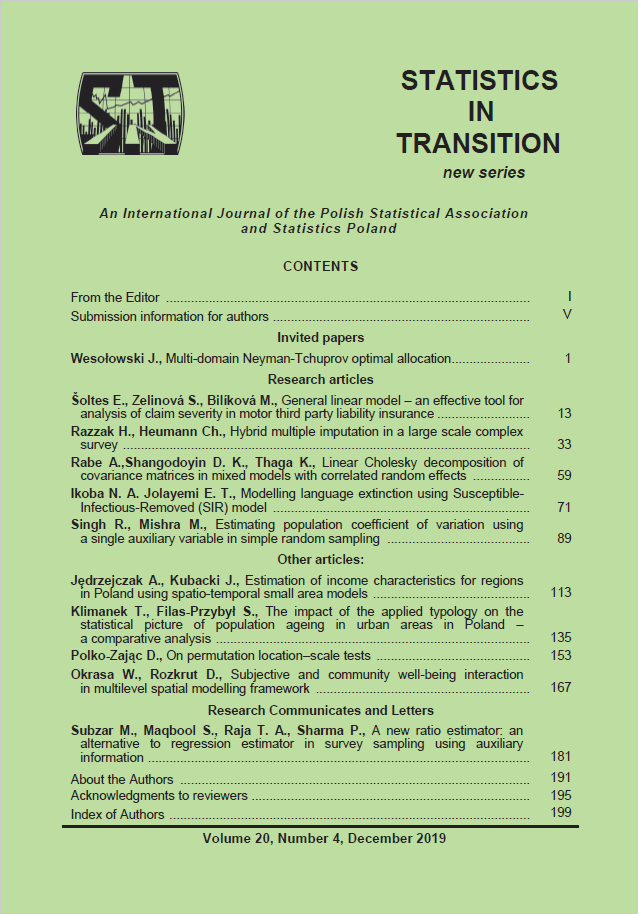ARTICLE
ABSTRACT
The paper focuses on the analysis of claim severity in motor third party liability insurance under the general linear model. The general linear model combines the analyses of variance and regression and makes it possible to measure the influence of categorical factors as well as the numerical explanatory variables on the target variable. In the paper, simple, main and interaction effects of relevant factors have been quantified using estimated regression coefficients and least squares means. Statistical inferences about least-squares means are essential in creating tariff classes and uncovering the impact of categorical factors, so the authors used the LSMEANS, CONTRAST and ESTIMATE statements in the GLM procedure of the Statistical Analysis Software (SAS). The study was based on a set of anonymised data of an insurance company operating in Slovakia; however, because each insurance company has its own portfolio subject to changes over time, the results of this research will not apply to all insurance companies. In this context, the authors feel that what is most valuable in their work, is the demonstration of practical applications that could be used by actuaries to estimate both the claim severity and the claim frequency, and, consequently, to determine net premiums for motor insurance (regardless of whether for motor third party liability insurance or casco insurance.
KEYWORDS
general linear model, claim severity, motor third party liability insurance, least squares means
REFERENCES
AGRESTI, A., (2015). Foundations of linear and generalized linear models, John Wiley & Sons.
ANDERSON, D., FELDBLUM, S., MODLIN, C., SCHIRMACHER, D., SCHIRMACHER, E., THANDI, N., (2007). A Practitioner’s Guide to Generalized Linear Models: A foundation for theory, interpretation and application (3rd ed.), Towers Watson.
CAI, W., (2014). Making Comparisons Fair: How LS-Means Unify the Analysis of Linear Models. SAS Institute Inc. Paper. SA, S060-2014. [online] http://citeseerx.ist.psu.edu/viewdoc/download?doi=10.1.1.644.7680&rep=rep1&type=pdf [Accessed on 30 April 2019].
DAVID, M., (2015). Auto insurance premium calculation using generalized linear models, Procedia Economics and Finance, 20, pp. 147–156, DOI: https://doi.org/10.1016/S2212-5671(15)00059-3.
DE AZEVEDO, F. C., OLIVEIRA, T. A., OLIVEIRA, A., (2016). Modeling non-life insurance price for risk without historical information, REVSTAT–Statistical Journal, 14(2), pp. 171–192. Available at: https://www.ine.pt/revstat/pdf/rs160205.pdf [Accessed on 30 April 2019].
DUAN, Z., CHANG, Y., WANG, Q., CHEN, T., ZHAO, Q., (2018). A Logistic Regression Based Auto Insurance Rate-Making Model Designed for the Insurance Rate Reform. International Journal of Financial Studies, 6(1), 18, DOI: https://doi.org/10.3390/ijfs6010018.
FOX, J., (2015. Applied regression analysis and generalized linear models. Sage Publications.
FREES, E., LEE, G., YANG, L., (2016). Multivariate frequency-severity regression models in insurance, Risks, 4(1), 4, DOI: https://doi.org/10.3390/risks4010004.
GOLDBURD, M., KHARE, A., TEVET, D., (2016). Generalized linear models for insurance rating, Casualty Actuarial Society, CAS Monographs Series, (5).
GRAHAM, J. M., 2008). The general linear model as structural equation modeling, Journal of Educational and Behavioral Statistics, 33(4), pp. 485–506, DOI: https://doi.org/10.3102/1076998607306151.
JONG, DE P., HELLER, G. Z., (2008). Generalized linear models for insurance data, Cambridge University Press.
KAFKOVÁ, S., KŘIVÁNKOVÁ, L., (2014). Generalized Linear Models in Vehicle Insurance. Acta Universitatis Agriculturae et Silviculturae Mendelianae Brunensis, 62(2), pp. 383–388, DOI: https://doi.org/10.11118/actaun201462020383.
KIM, K., TIMM, N., (2006). Univariate and multivariate general linear models: theory and applications with SAS. Chapman and Hall/CRC.
KUZNETSOVA, A., BROCKHOFF, P. B., CHRISTENSEN. R. H. B., (2017). lmerTest package: tests in linear mixed effects models. Journal of Statistical Software, 82(13), DOI: https://doi.org/10.18637/jss.v082.i13.
LAMOTTE, L. R., (2019). A formula for Type III sums of squares. Communications in Statistics-Theory and Methods, pp. 1–11, DOI: https://doi.org/10.1080/03610926.2019.1586933.
LENTH, R. V., (2016). Least-squares means: the R package lsmeans. Journal of statistical software. 69(1), pp. 1–33, DOI: https://doi.org/10.18637/jss.v069.i01.
LITTELL, C. L., STROUP, W. W., FREUND, R. J., (2010). SAS for Linear Models (4th Revised ed.). North Carolina, USA: SAS Institute.
SHI, P., FENG, X., IVANTSOVA, A., (2015). Dependent frequency–severity modeling of insurance claims. Insurance: Mathematics and Economics, 64, pp. 417–428. DOI: https://doi.org/10.1016/j.insmatheco.2015.07.006.
THOMPSON, B., (2015). The Case for Using the General Linear Model as a Unifying Conceptual Framework for Teaching Statistics and Psychometric Theory. Journal of Methods and Measurement in the Social Sciences, 6(2), pp. 30–41, DOI: https://doi.org/10.2458/azu_jmmss_v6i2_thompson.
WILCOX, R. R., (2003). Applying contemporary statistical techniques, Elsevier.
WOOLDRIDGE, J. M., (2013). Introductory econometrics: A modern approach (5th ed.), Mason: South-Western.
